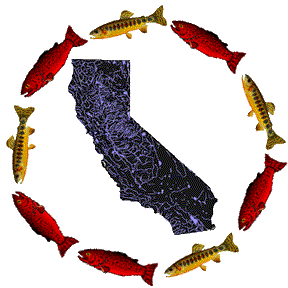|
CSPA |
| Your 501(c)(3) tax deductible cash donations are desperately needed if the fight for our fisheries is to continue. Read how you can donate! |

 More
News
More
News
![]()
 CSPA
News
CSPA
News
Caples Lake, why the repairs? Why now?
by Jerry Neuburger
August 20, 2008. -- In mid June, the El Dorado Irrigation District (EID)
completed an underwater survey of the Caples Lake and Silver Lake dams.
According to their website, "underwater investigation at Caples Lake revealed major
problems with two slide gates. The gates are located in a well-like
shaft within the dam. Of particular concern is the lower gate that is
about 64 feet under water when the lake is full." EID purchased the dam in 1999, when PG&E sold off many of their
Sierra hydro projects. In addition to the Caples operation, EID also
purchased the Silver Lake project, seven miles west and lower in
elevation.
Following that inspection EID developed a planned repair schedule for both facilities. The repairs were originally scheduled for the fall of 2009, however in early July, the district found a manufacturer that could furnish the necessary parts for the repairs in time to complete them in 2008. However to do so, the district would need to bypass all of the necessary review procedures required by various agencies.
To facilitate the repairs, EID declared an emergency situation. By declaring an “emergency,” it allowed reviewing agencies to sign off on their responsibilities, the environmental review process was bypassed and there was no formal process or independent review evaluating alternatives that might avoid or lessen impacts to the lake's fishery or the impact on local businesses. Once these safeguards were waived, the repairs were scheduled for September of 2008 and the draw down of the lake began.
A controversy began when area businesses, residents and anglers learned that EID's plan for repairs would necessitate the draw down of the lake to a minimum that would almost guarantee the death of the fishery. The lake is considered to be one of the "jewels" of the Sierra due to the large and varied population of trout that the lake supports. The small pool left from the lake's 22,500 acre feet maximum is believed to be inadequate to allow the lakes fish population to winter over because of the severe winter freeze and lack of oxygen resulting.
Had normal procedures been followed, EID would have had to walk through the steps required by the California Environmental Quality Act (CEQA) which would have required review by a number of agencies and allowed for public input.
The hearing would have allowed local businesses and fishermen a forum for investigating potential alternatives that would possibly avoid or lessen adverse consequences. Could the project be conducted next year following environmental review? Could a higher cofferdam be constructed? Could a bladder be placed in the outlet tunnel allowing a dry repair? Could the lake be oxygenated?
Once committed to the draw down, it was questionable whether a fish rescue was feasible. However after some deliberation, DFG and EID agreed to attempt the same and to transport rescued fish to Silver Lake, seven miles west of Caples. When the rescue attempt was made known at a recent meeting, David Lass of Truckee, Northern California field coordinator for Trout Unlimited, offered the services of his organization to help in the project.
Chris Shutes, CSPA FERC Projects Director attended a following meeting to review the entire situation since Caples Lake is part of a hydroelectric project licensed by Federal Energy Regulatory Commission as project 184. The rapid sequence of events, including the approval of the emergency status of the project led CSPA to determine that while the repairs had been to some extent, railroaded, intervention attempts were now beyond any realistic chance of success.
While CSPA felt that due process was needlessly put aside, the best option seemed to be to support the rescue efforts and, at the same time, further investigate the situation on Silver Lake where similar repairs are necessary to the dam. These repairs are scheduled for 2009, and do not require such drastic measures. However, that is no guarantee that the fishery in Silver Lake will not be impacted by the lake's repairs. CSPA will consider seeking full CEQA review before allowing the Silver Lake repairs to go forward.
In addition to the above concerns, the entire set of circumstances has caused the leadership of CSPA to raise some serious questions. Why did it take nine years to discover the deteriorating state of the dam's operating equipment? Why isn't there a schedule calling for regular inspection and maintenance? Why wasn't the dam inspected at the time of transfer from PG&E to IED?
Since the dam at Silver Lake was found to have similar problems, an even larger question needs to be answered. Of the dozens, maybe in excess of a hundred, aging dams in the Sierra, most owned by various power and irrigation districts, how many are in this condition or worse? The Caples Lake issue may be just the tip of the iceberg in the deterioration of an aging water and power infrastructure.